
Acianthus, commonly known as mosquito orchids, is a genus of about twelve species of plants in the orchid family, Orchidaceae. Mosquito orchids are terrestrial herbs with a single, heart-shaped, usually ground-hugging leaf and one to many small, green, pinkish or purplish flowers on a fleshy stalk. They are found in New Caledonia, Australia and New Zealand.
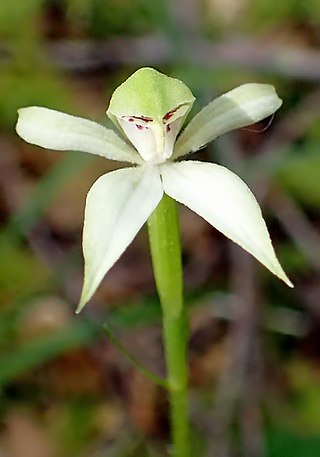
Adenochilus, commonly known as gnome orchids is a genus of two species of flowering plants in the orchid family Orchidaceae, one endemic to New Zealand and the other to Australia. Both species have a long, horizontal, underground rhizome with a single leaf on the flowering stem and a single resupinate flower with its dorsal sepal forming a hood over the labellum and column.
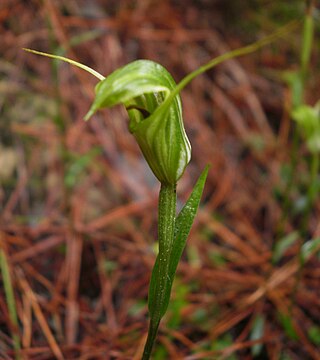
Pterostylis trullifolia, commonly known as the trowel-leaved greenhood, is an orchid species endemic to New Zealand. As with similar orchids, the flowering plants differ from those which are not flowering. The non-flowering plants have a rosette of wrinkled, trowel-shaped leaves but the flowering plants have a single flower with a bulging, platform-like sinus between the lateral sepals and leaves on the flowering spike.
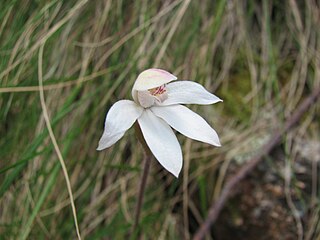
Caladenia alpina, commonly known as the mountain caladenia, is a species of plant in the orchid family Orchidaceae and is native to subalpine areas of south-eastern Australia and to New Zealand. It has a single fleshy leaf and a thin wiry flowering spike bearing two white flowers with red bars on the labellum. In New Zealand this orchid is sometimes known as Caladenia lyallii.
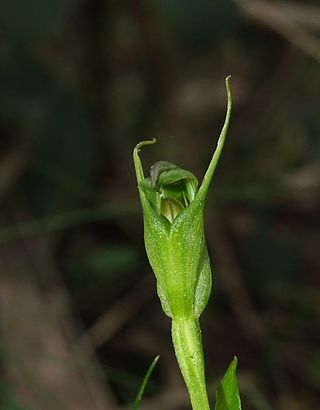
Pterostylis foliata, commonly known as the slender greenhood, is a species of orchid widespread in south-eastern Australia and New Zealand. Flowering plants have a rosette of three to six, dark green, crinkled leaves crowded around the flowering stem and a single dark green and brown flower with a deep V-shaped sinus between the lateral sepals.

Pterostylis australis, commonly known as the southern greenhood, is a species of orchid endemic to New Zealand. Unlike many other greenhood orchids, this species lacks a rosette of leaves but instead only has leaves on the flowering stem. The leaf's shape differs according to it position on the stem and there is a single green and white-striped flower. This greenhood occurs on both of the main islands of New Zealand and often forms large colonies.

Pterostylis graminea, commonly known as the grass-leaved greenhood, is a species of orchid endemic to New Zealand. It has erect, grass-like leaves with the upper ones higher than the yellowish-green and transparent white flower.
Pterostylis puberula, commonly known as the dwarf greenhood or snail greenhood is a species of orchid which is endemic to New Zealand. It has a rosette of pale yellowish, stalked leaves and a single silvery-white and green flower with relatively long, erect lateral sepals.

Prasophyllum colensoi is a species of orchid endemic to New Zealand where it is commonly known as the leek orchid. It has a single tubular, dark green leaf and up to twenty scented, yellowish-green to reddish-brown flowers. It is similar to P. hectori, the only other species of Prasophyllum found in New Zealand, but is distinguished from it by its smaller size, fewer flowers and different habitat.
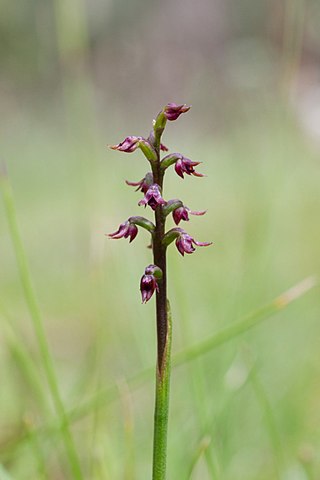
Genoplesium nudum, commonly known as the tiny midge orchid in Australia or the red midge orchid in New Zealand, is a small terrestrial orchid native to south-eastern Australia and New Zealand. It has a single thin leaf fused to the flowering stem and up to forty small, reddish-purple or green and red flowers. Australian and New Zealand authorities use the name Corunastylis nuda but Genoplesium nudum and Prasophyllum transversum are used by the World Checklist of Selected Plant Families.

Genoplesium nudiscapum, commonly known as the bare midge orchid, is a species of small terrestrial orchid endemic to Tasmania. It has a single thin leaf fused to the flowering stem and up to twenty small, green and reddish-brown flowers. It was thought to be extinct, since it had not been seen since 1852 but was rediscovered in 2008. The species has also been described as occurring on continental Australia. The species is known as Corunastylis nudiscapa in Tasmania.
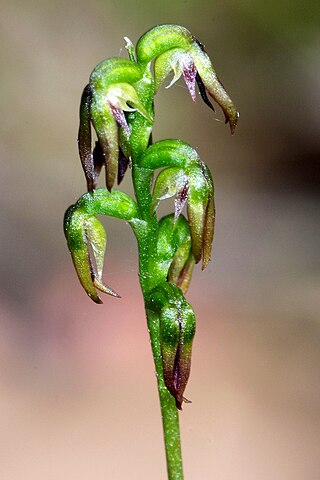
Genoplesium despectans, commonly known as the sharp midge orchid and known as Corunastylis despectans in Australia, is a small terrestrial orchid endemic to south-eastern Australia. It has a single thin leaf fused to the flowering stem and up to forty five small, dark purple or green and purple flowers.
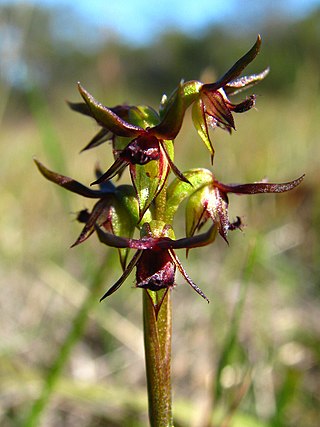
Genoplesium archeri, commonly known as the elfin midge orchid and as Corunastylis archeri in Australia, is a small terrestrial orchid endemic to south-eastern Australia. It has a single thin leaf fused to the flowering stem and up to fifteen small, hairy, yellowish green flowers with purple stripes. It grows in a wide range of habitats in New South Wales, Victoria and Tasmania.

Genoplesium pumilum, commonly known as the green midge orchid in Australia, and the yellow gumland leek orchid in New Zealand is a small terrestrial orchid native to south-eastern Australia and New Zealand. It has a single thin leaf fused to the flowering stem and up to twenty five green to yellowish-green flowers which sometimes have red markings. Australian and New Zealand authorities use the name Corunastylis pumila.

Chiloglottis cornuta, commonly known as the green bird orchid, is a species of orchid found in south-eastern Australia and in New Zealand, including many of its offshore islands. It has two broad leaves and a single green or pinkish flower with six to eight rounded, flattened green, reddish or blackish calli on the labellum.
Cyrtostylis oblonga, commonly known as the winter orchid or gnat orchid, is a species of orchid endemic to New Zealand. It has a single rounded leaf and a flowering stem with up to four pink or pinkish green flowers with a flat, oblong labellum.
Cyrtostylis rotundifolia, commonly known as the winter orchid or gnat orchid, is a species of orchid endemic to New Zealand. It has a single egg-shaped leaf and a flowering stem with up to four pink or pinkish green flowers with a flat, oblong labellum. It is very similar to Cyrtostylis oblonga and more investigation is required to determine if they are distinct from each other.
Townsonia viridis, commonly known as the beech orchid, is a species of orchid endemic to Tasmania. It forms diffuse colonies with tiny, inconspicuous flowers and small, more or less round leaves and grows mainly in mossy places in myrtle beech forest.

Corybas acuminatus, commonly known as the dancing spider orchid or helmet flower, is a species of terrestrial orchid endemic to New Zealand. It has a triangular, sharply pointed leaf and a small translucent, greenish-white flower with purple markings and with very long sepals. It is found on both the main islands of New Zealand and also some of the off-shore islands.
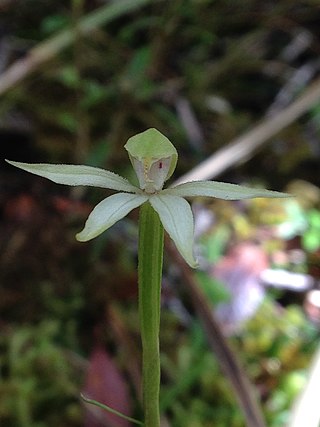
Adenochilus gracilis is a species of plant in the orchid family Orchidaceae and is endemic to New Zealand. It has a long, thin underground rhizome, a single leaf on the flowering stem and a single white flower with glandular hairs on the outside. Its labellum has red to maroon bars and a central band of yellow calli, but is almost obscured by the dorsal sepal.
















